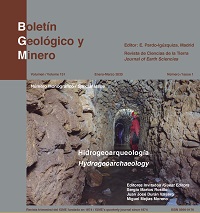The Vascos site: potential use of groundwater for water supply
DOI:
https://doi.org/10.21701/bolgeomin.131.1.010Keywords:
hydrogeoarcheology, groundwater integral system of resource management, Vascos site, sandy granitic regolithAbstract
The Muslim city of Vascos (Navalmoralejo, Toledo) was inhabited from the 9th to the11th centuries A.D. The reasons that justify its specific location are unknown, although the latest research considers this settlement to be a centre related to metallurgical work. The archaeological excavations carried out evidence a population greater than a thousand inhabitants. A city of such a magnitude must have had a water supply system, sufficient to meet the demand of the population, as well for derived secondary activities. Today some archaeological remains both inside and outside the city have been identified, which could be related to the original supply system. It is considered that the possibilities of water supply were complicated when the geological, hydrogeological and weather conditions are taken into account. This difficulty raises the hypothesis of a water supply and possibly of underground origin. After an analysis of the hydrogeological conditions of the environment, and in line with the identified remains, a possible supply system is proposed, characterized by the maximum use of available surface and underground water resources. This system combines waters of both origins, thus forming a truly integral system of resource management that arose as a result of a shortage of temporary water in the surroundings of the city of Vascos.
Downloads
References
Benito, G., Díaz Herrero, A. y Fernández de Villanta, M. 2003a. Magnitude and frequency of flooding in the Tagus basin (Central Spain) over the last millennium. Climatic Change 58: 171-192.
Benito, G., Sopeña, A., Sánchez-Moya, Y. Machado, M.J. y Pérez González, A. 2003b. Paleofloods record in the Tagus river (Central Spain) during de Late Pleistocene and Holocene. Quaternary Science Reviews, nº 22, 1737-1756. https://doi.org/10.1016/S0277-3791(03)00133-1
Clariana García, M.P., Rubio Pascual, F., Montes Santiago, M.J. y González Clavijo, E.J. Mapa Geológico Digital continuo E. 1:50.000, Zona Centroibérica. Dominio esquistoso-grauváquico y Cuenca del Guadiana (Zona 1400). In GEODE. Mapa Geológico Digital continuo de España. En línea [febrero de 2019]. Disponible en: http://info.igme.es/cartografiadigital/geologica/geodezona.aspx?Id=Z1400
Cosín Corral, Y. 1996. Un ejemplo de minería islámica: la ciudad hispanomusulmana de Vascos (Navalmoralejo, Toledo), en Arqueología e Historia de la minería y metalurgia. Escuela Técnica Superior de Ingenieros de Minas. Madrid, 106-119.
CHT, 2015. Documento auxiliar A05.2. Fichas por masas de agua de la distribución temporal de caudales mínimos por métodos hidrológicos en ríos con no permanentes. Periodo de cese. En: Plan hidrológico de la parte española de la Demarcación Hidrográfica del Tajo 2015-2021. Madrid.
Custodio, E. y Llamas Madurga, M.R. 1983. Manual de Hidrología subterránea. Ediciones Omega. Barcelona, 2334 pp.
Font Tullot, I. 1988. Historia del clima de España: Cambios climáticos y sus causas. Instituto Nacional de Meteorología. Madrid. 297 pp.
Izquierdo, R. 1986. Los baños árabes de Vascos (Navalmoralejo, Toledo). Noticiario Arqueológico Hispánico, nº 28. 193-242.
Izquierdo, R. 1994. Vascos (Navalmoralejo, Toledo). Campañas 1983 1988. Servicio de Publicaciones de la Junta de Comunidades de Castilla-La Mancha, 195 págs.
Izquierdo, R. 1996. Unas tenerías excavadas en la ciudad hispanomusulmana de Vascos (Toledo). Arqueología y Territorio Medieval, 3. 149165. https://doi.org/10.17561/aytm.v3i0.1627
Izquierdo, R. 2005. Una ciudad de la marca media: Vascos (Toledo). Arqueología y territorio medieval. Volumen 12, nº 2. 35-55. https://doi.org/10.17561/aytm.v12i2.1710
Izquierdo, R. y Prieto, G. 1989. Los sistemas hidráulicos de la ciudad hispanomusulmana de Vascos. Coloquio de Historia y Medio Físico I. Almería. 469-486.
Julivert, M., Fontboté, J.M., Ribeiro, A. y Conde, L.S. 1977. Mapa tectónico de la península Ibérica y Baleares E: 1:1.000.000. Instituto Geológico y Minero de España.
Julivert, M., Vegas, R. Roiz, J.M. y Martínez Rius, A. 1983. La estructura de la parte SE de la Zona Centroibérica con metamorfismo de bajo grado. En el Libro jubilar J.M. Ríos. Instituto Geológico y Minero de España. Madrid. 477-490.
MAPAMA, 2015. Anuario de aforos: Red Oficial de Estaciones de Aforo (ROEA). [En línea]. [Fecha de consulta: octubre de 2018]. Disponible en: https://www.miteco.gob.es/es/cartografia-y-sig/ide/descargas/agua/anuario-de-aforos.aspx
Martos Rosillo, S., Ruíz Constán, A., Martín Civantos, J.M., Marín Lechado, C., González Ramón, A. y Pedrera Parias, A. 2019. Careos: siembra y cosecha de agua en la cuenca del río Bérchules (Sierra Nevada, Granada). Ed. Instituto Geológico y Minero de España. Madrid, 84 págs.
Olivé, A., Álvaro, M., Monteserín, V. Andonaegui, P. 1989. Memoria de la Hoja nº 654 (Puente del Arzobispo). Mapa Geológico de España E. 1:50.000 (MAGNA), Segunda Serie, Primera edición. IGME, 22 pp. Depósito legal: M-25565-1989.
Trillo San José, C. 2006. El agua en al-Ándalus: teoría y aplicación según la cultura islámica. Tecnología del agua, 271, 2-10.
Vera, J.A. 2004. Ed. principal. Geología de España. Sociedad Geológica de España e Instituto Geológico y Minero de España. Madrid, 880 pp.
Downloads
Published
How to Cite
Issue
Section
License
Copyright (c) 2024 Consejo Superior de Investigaciones Científicas (CSIC)

This work is licensed under a Creative Commons Attribution 4.0 International License.
© CSIC. Manuscripts published in both the print and online versions of this journal are the property of the Consejo Superior de Investigaciones Científicas, and quoting this source is a requirement for any partial or full reproduction.
All contents of this electronic edition, except where otherwise noted, are distributed under a Creative Commons Attribution 4.0 International (CC BY 4.0) licence. You may read the basic information and the legal text of the licence. The indication of the CC BY 4.0 licence must be expressly stated in this way when necessary.
Self-archiving in repositories, personal webpages or similar, of any version other than the final version of the work produced by the publisher, is not allowed.















